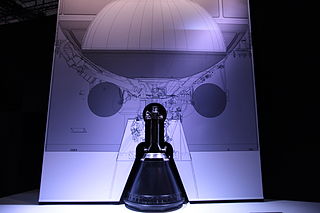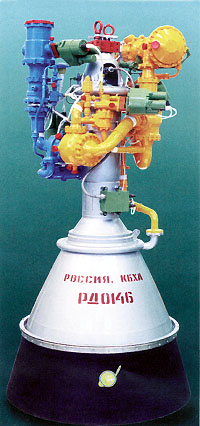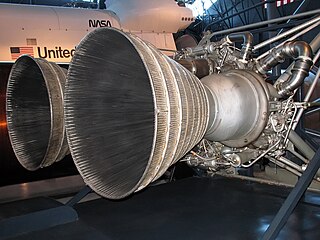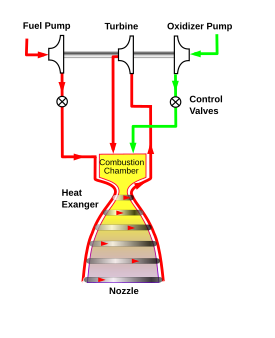
A turbopump is a propellant pump with two main components: a rotodynamic pump and a driving gas turbine, usually both mounted on the same shaft, or sometimes geared together. They were initially developed in Germany in the early 1940s. The purpose of a turbopump is to produce a high-pressure fluid for feeding a combustion chamber or other use. While other use cases exist, they are most commonly found in liquid rocket engines.

The Aerojet Rocketdyne RS-25, also known as the Space Shuttle Main Engine (SSME), is a liquid-fuel cryogenic rocket engine that was used on NASA's Space Shuttle and is used on the Space Launch System (SLS).

The F-1, commonly known as Rocketdyne F-1, is a rocket engine developed by Rocketdyne. This engine uses a gas-generator cycle developed in the United States in the late 1950s and was used in the Saturn V rocket in the 1960s and early 1970s. Five F-1 engines were used in the S-IC first stage of each Saturn V, which served as the main launch vehicle of the Apollo program. The F-1 remains the most powerful single combustion chamber liquid-propellant rocket engine ever developed.

The J-2, commonly known as Rocketdyne J-2, was a liquid-fuel cryogenic rocket engine used on NASA's Saturn IB and Saturn V launch vehicles. Built in the United States by Rocketdyne, the J-2 burned cryogenic liquid hydrogen (LH2) and liquid oxygen (LOX) propellants, with each engine producing 1,033.1 kN (232,250 lbf) of thrust in vacuum. The engine's preliminary design dates back to recommendations of the 1959 Silverstein Committee. Rocketdyne won approval to develop the J-2 in June 1960 and the first flight, AS-201, occurred on 26 February 1966. The J-2 underwent several minor upgrades over its operational history to improve the engine's performance, with two major upgrade programs, the de Laval nozzle-type J-2S and aerospike-type J-2T, which were cancelled after the conclusion of the Apollo program.

The Rocketdyne H-1 was a 205,000 lbf (910 kN) thrust liquid-propellant rocket engine burning LOX and RP-1. The H-1 was developed for use in the S-I and S-IB first stages of the Saturn I and Saturn IB rockets, respectively, where it was used in clusters of eight engines. After the Apollo program, surplus H-1 engines were rebranded and reworked as the Rocketdyne RS-27 engine with first usage on the Delta 2000 series in 1974. RS-27 engines continued to be used up until 1992 when the first version of the Delta II, Delta 6000, was retired. The RS-27A variant, boasting slightly upgraded performance, was also used on the later Delta II and Delta III rockets, with the former flying until 2018.

The RL10 is a liquid-fuel cryogenic rocket engine built in the United States by Aerojet Rocketdyne that burns cryogenic liquid hydrogen and liquid oxygen propellants. Modern versions produce up to 110 kN (24,729 lbf) of thrust per engine in vacuum. Three RL10 versions are in production for the Centaur upper stage of the Atlas V and the DCSS of the Delta IV. Three more versions are in development for the Exploration Upper Stage of the Space Launch System and the Centaur V of the Vulcan rocket.

The staged combustion cycle is a power cycle of a bipropellant rocket engine. In the staged combustion cycle, propellant flows through multiple combustion chambers, and is thus combusted in stages. The main advantage relative to other rocket engine power cycles is high fuel efficiency, measured through specific impulse, while its main disadvantage is engineering complexity.

The gas-generator cycle, also called open cycle, is one of the most commonly used power cycles in bipropellant liquid rocket engines. Part of the unburned propellant is burned in a gas generator and the resulting hot gas is used to power the propellant pumps before being exhausted overboard, and lost. Because of this loss, this type of engine is termed open cycle.

The Aerojet M-1 was one of the largest and most powerful liquid-hydrogen-fueled liquid-fuel rocket engine to be designed and component-tested. It was originally developed during the 1950s by the US Air Force. The M-1 offered a baseline thrust of 6.67 MN and an immediate growth target of 8 MN. If built, the M-1 would have been larger and more efficient than the famed F-1 that powered the first stage of the Saturn V rocket to the Moon.

Vinci is a European Space Agency cryogenic liquid rocket engine under development as of 2020. It is designed to power the new upper stage of Ariane 6.
The YF-75 is a liquid cryogenic rocket engine burning liquid hydrogen and liquid oxygen in a gas generator cycle. It is China's second generation of cryogenic propellant engine, after the YF-73, which it replaced. It is used in a dual engine mount in the H-18 third stage of the Long March 3A, Long March 3B and Long March 3C launch vehicles. Within the mount, each engine can gimbal individually to enable thrust vectoring control. The engine also heats hydrogen and helium to pressurize the stage tanks and can control the mixture ratio to optimize propellant consumption.

The YF-77 is China's first cryogenic rocket engine developed for booster applications. It burns liquid hydrogen fuel and liquid oxygen oxidizer using a gas generator cycle. A pair of these engines powers the LM-5 core stage. Each engine can independently gimbal in two planes. Although the YF-77 is ignited prior to liftoff, the LM-5's four strap-on boosters provide most of the initial thrust in an arrangement similar to the European Vulcain on the Ariane 5 or the Japanese LE-7 on the H-II.

The LE-7 and its succeeding upgrade model the LE-7A are staged combustion cycle LH2/LOX liquid rocket engines produced in Japan for the H-II series of launch vehicles. Design and production work was all done domestically in Japan, the first major (main/first-stage) liquid rocket engine with that claim, in a collaborative effort from the National Space Development Agency (NASDA), Aerospace Engineering Laboratory (NAL), Mitsubishi Heavy Industries, and Ishikawajima-Harima. NASDA and NAL have since been integrated into JAXA. However, a large part of the work was contracted to Mitsubishi, with Ishikawajima-Harima providing turbomachinery, and the engine is often referred to as the Mitsubishi LE-7(A).

The LE-5 liquid rocket engine and its derivative models were developed in Japan to meet the need for an upper stage propulsion system for the H-I and H-II series of launch vehicles. It is a bipropellant design, using LH2 and LOX. Primary design and production work was carried out by Mitsubishi Heavy Industries. In terms of liquid rockets, it is a fairly small engine, both in size and thrust output, being in the 89 kN (20,000 lbf) and the more recent models the 130 kN (30,000 lbf) thrust class. The motor is capable of multiple restarts, due to a spark ignition system as opposed to the single use pyrotechnic or hypergolic igniters commonly used on some contemporary engines. Though rated for up to 16 starts and 40+ minutes of firing time, on the H-II the engine is considered expendable, being used for one flight and jettisoned. It is sometimes started only once for a nine-minute burn, but in missions to GTO the engine is often fired a second time to inject the payload into the higher orbit after a temporary low Earth orbit has been established.
The RL60 was a planned liquid-fuel cryogenic rocket engine designed in the United States by Pratt & Whitney, burning cryogenic liquid hydrogen and liquid oxygen propellants. The engine runs on an expander cycle, running the turbopumps with waste heat absorbed from the main combustion process. This high-efficiency, waste heat based combustion cycle combined with the high-performance liquid hydrogen fuel enables the engine to reach a very high specific impulse of up to 465 seconds in a vacuum. The engine was planned to be a more capable successor to the Aerojet Rocketdyne RL10, providing improved performance and efficiency while maintaining the installation envelope of the RL10.

A cryogenic rocket engine is a rocket engine that uses a cryogenic fuel and oxidizer; that is, both its fuel and oxidizer are gases which have been liquefied and are stored at very low temperatures. These highly efficient engines were first flown on the US Atlas-Centaur and were one of the main factors of NASA's success in reaching the Moon by the Saturn V rocket.

The RD-0146 (РД-0146) is a liquid-fuel cryogenic rocket engine developed by KBKhA Kosberg in Voronezh, Russia.

The LR87 was an American liquid-propellant rocket engine used on the first stages of Titan intercontinental ballistic missiles and launch vehicles. Composed of twin motors with separate combustion chambers and turbopump machinery, it is considered a single unit and was never flown as a single combustion chamber engine or designed for this. The LR87 first flew in 1959.
TM65 is a rocket engine developed by Copenhagen Suborbitals. TM65 uses Ethanol and liquid oxygen as propellants in a pressure-fed power cycle.
The MARC-60, also known as MB-60, MB-XX, and RS-73, is a liquid-fuel cryogenic rocket engine designed as a collaborative effort by Japan's Mitsubishi Heavy Industries and US' Aerojet Rocketdyne. The engine burns cryogenic liquid oxygen and liquid hydrogen in an open expander cycle, driving the turbopumps with waste heat from the main combustion process.

















